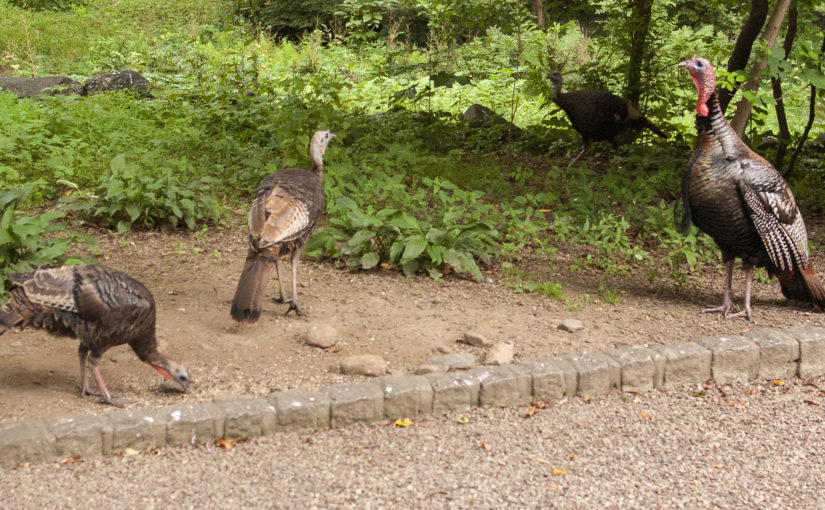Last week I started working at a home with several bird feeders. It’s amazing the birds a good feeder will attract.
Author: John Holden
-

It’s Monday Morning and I’m Ready to Work
One of my rituals on office days is to clean the office before starting work. I can’t decide if cleaning is a stalling tactic or productivity tweak.
Clutter is a huge productivity killer for me. My brain can’t start solving problems or being creative in clutter.
Everything in it’s place and a place for everything.
I keep a bottle of Windex and paper towels in the office to clean the desktop, computer monitor and everything else on my desk. A damp paper towel picks up dust and has yet to scratch my computer monitor.
A quick run of the vacuüm across the floor keeps Theo’s furballs at bay for at least the morning.
The fish tank looked a little cloudy so I siphoned out some water, cleaned the glass and topped off the tank.
My children won Shimmer and Zoomer at a carnival 4 years ago. I often glance over at their tank and see them staring at me trying to convince me to feed them more.

Shimmer is the fish on the left. He’s named Shimmer because of his shiny scales. Zoomer on the right darts off when she or he feels threatened. The last touch is to light a Candle. A candle sets the tone for the day by relaxing me. I save the candle for when I’ll be in the office most of the day.
I also cleaned, fed and watered Minnie. Here’s a video of Minnie, named after Minnie Mouse because of her black ears, if you’re interested.
Time to get to work.
-
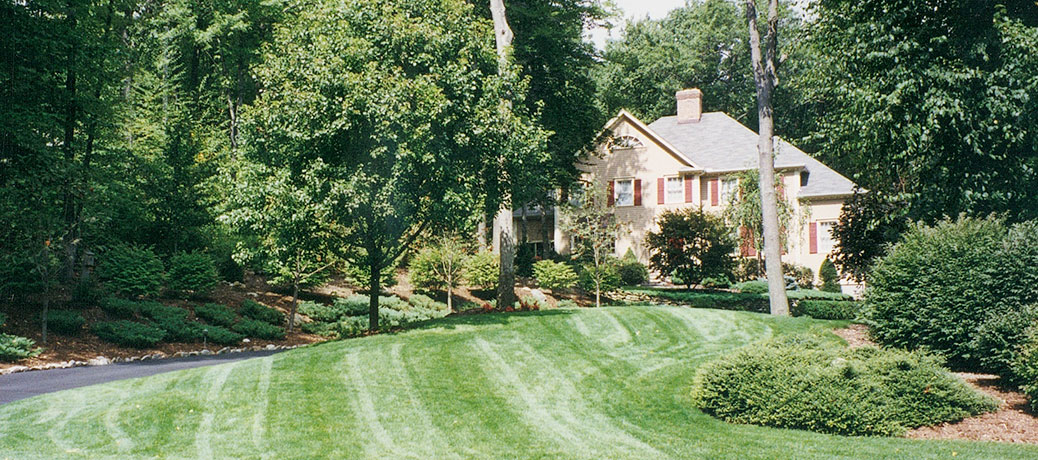
Lawn Mowing Tips
The lawn mowing tips below will make a huge difference in the health and appearance of your lawn.
Lawn Mowing Tips
1. Mow often. In the spring mow your lawn twice a week to keep up with growth.
2. Remove 1/3 or less of the grass-blade when mowing. Removing 1/3 or less of the grass-blade minimizes stress on your lawn.
If your lawn is overgrown raise the mower 2-3 notches before mowing. A few days later mow at the proper height to decrease stress. The worst thing you can do to an overgrown lawn is scalp it like a hay-field.
3. Mow high. Set your mower at 2.5″ for the first mowing of the season. Mowing lower the first cut helps grind up winter debris.
Raise the mower a notch each mowing until you reach 3.5 – 4″. Tall grass means deeper roots that reach into the soil for moisture. Tall grass also shades out weeds such as crabgrass and chickweed.
Lower your mower a notch at a time as leaf cleanup season arrives.
4. Keep mower blades sharp. Grass cut with a sharp blade cleanly cuts the grass-blade. Grass cut with a dull blade tears the grass-blade.
You can tell how sharp a mower blade is by looking at the lawn from a distance. If you see a brown cast the blades are dull.
Start the season with a sharp mower blade. After the first few cuts, sharpen the blade again. Mower blades often gets nicked or dulled the first few cuts of the season. Then, sharpen your mower blade half way through the season.
Keep two sets of mower blades so you have a sharp blade available when you need one.
5. Leave clippings on the lawn. Grass clippings return much-needed nitrogen to your lawn. Some people believe grass clippings create thatch. They don’t. Over fertilizing lawns kills microbes that break down thatch. Removing more than 1/3 of the grass-blade creates more thatch than microbes can break down.
6. Mow late in the afternoon. The cooler temperatures and higher humidity during the night reduce stress from mowing.
7. Mow when grass is dry. Mowing wet grass encourages the spread of disease. Mowing wet grass also pushes grass over leaving a ragged cut. Finally, mowing wet grass leaves unsightly clumps that make a mess of everything. Wait for you lawn to dry before mowing.
8. Alternate mowing patterns. Mow your lawn in a different direction weekly to prevent pushing grass-blades over and prevent ruts. Alternate mowing direction at 90 and 45 degree angles .

Vary the direction you mow weekly by alternating between perpendicular and angular patterns. 9. Use a mulching blade. Mulching mower blades cut clippings into fine pieces before leaving the mower deck. This is the only type of mower blade I recommend.
The lawn mowing tips above take a little extra effort from your mowing crew or the designated mower of the house (You know who you are). While it’s OK to break the rules once in a while the closer you can come to them the better your lawn will look.
Happy mowing!
-
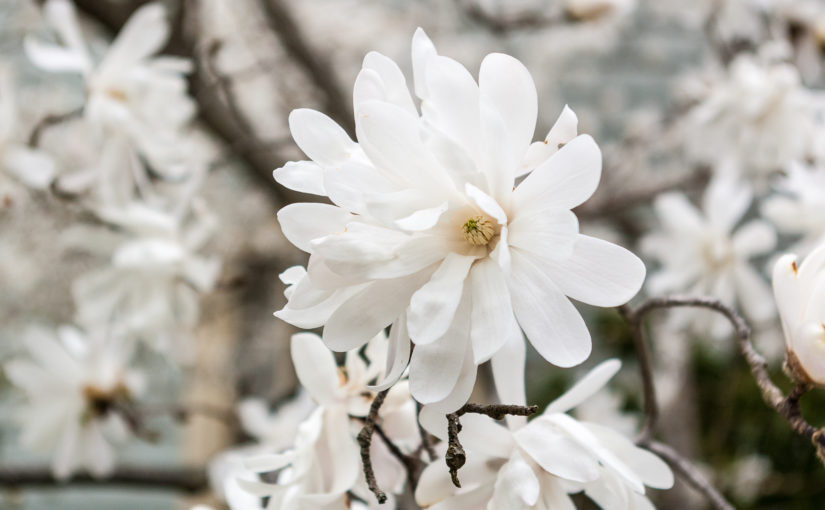
Early Spring Blooming Plants – Part 1
I visited the Bartlett Arboretum in mid-April and had a ball looking at early spring blooming plants. Below are some pictures from my visit.
Cornell Pink Rhododendron (Rhododendron mucronulatum ‘Cornell Pink’)

Cornell Pink Rhododendron was in full bloom. Cornell Pink is a deciduous rhododendron and blooms before foliage emerges. 
A close up of Cornell Pink Rhododendron flowers. Winter Hazel (Corylopsis pauciflora)

Winter Hazel in full bloom. I’ve never planted it but I like the compact habit and bright yellow blooms in early-spring. 
Winter Hazel flowers aren’t big but there’s enough of them to catch your eye. Lenten Rose Sp. (Helleborus sp.)

The Lenten Rose was in full bloom. You can see last years foliage under the flowers. If you have Lenten Rose you can prune the foliage back in early winter once it goes dormant or early spring. There’s no harm if you don’t cut back last years foliage before bloom. Star Magnololia (Magnolia Stellata)

Gorgeous! Absolutely gorgeous. 
Because they flower so early Star Magnolia blooms are often damaged by frost. These blooms are as good as it gets for Star Magnolia. More pictures from my visit coming soon.
-

A Day That Changed My Life Forever
It was a Saturday morning and I had a 10:00 appointment with a client 30 minutes away. My family and I were off to visit a lighthouse when I returned.
My client wanted me to look at a landscape a local nursery planted six months earlier.
They spent over $7,000 on a landscape that gave them no pleasure.
It was a classic case of a nursery installing a job late in the season.
The nursery used the leftover plants they had in stock. Specimens sprung from the landscape with no sense of purpose and there was no continuity to the design. Weeds were breaking through the dusting of mulch.
My heart went out to those poor people. There was little, if any, landscape design or installation skill used in the planting.
I gave them an estimate of 3-4 k to mend the landscape because you have to move, and remove, a lot of plants. A landscape design to work from required a $300 investment for travel, materials and design time.
I left the visit waiting for a call that never came.
When I returned home at noon my family and I were off to visit the lighthouse. We never made it inside. There was a 3 hour wait to get in.
This wasn’t the first time I met a potential client and didn’t get the job. I’m sure it won’t be the last.
Something about that day left an impression on me.
After 25 years of free consultations I knew it was time for a change.
If you’re considering hiring my company I welcome your call. I’m happy to discuss your needs and see if we’re a good fit for you.
If you’d like me to visit your home please know that I charge for consultations with future clients. This consultation gets you the knowledge I’ve learned in 25 plus years working in the field and my degree in Ornamental Horticulture.
The consultation charge justifies that you, and I, value my time.
If you’re not interested in paying for a consultation I know a nursery that will be glad to help.
-

How Does a Tree Heal
A tree forms callous tissue to cover wounds. How quickly a tree heals depends on the size of the wound and where it’s cut.
The Sugar Maple cross-section at the top of this post shows a well healed wound. You can see the cut and the callous tissue that closed the wound.
Below is the same wound from the outside.
This Choke Cherry stump grew around suckers cut years before. I can’t say the tree was ‘healing’ but the picture demonstrates how a tree envelops objects.
In elementary school we’re taught to count a trees rings to learn the trees age. Growth rings also give us a clue to a trees health.
The growth rings on this White Oak are very close for many years. There may have been a drought, lighting strike or a pest attacking the tree.
The rings are so close because the tree was healing from pruning and lost a lot of its canopy causing stunted growth.
The Three Cut Method of Pruning
When splitting wood I see all kinds of neat things demonstrating how trees grow. The video below showcases healed wounds and shows the three cut method for pruning trees.
If you just want to learn about the three cut method skip to the second half of the video.
-

Fall in Love with Some Activity
A viewer on my YouTube Channel shared this quote with me. I think you’ll enjoy it too.
Fall in love with some activity, and do it! Nobody ever figures out what life is all about, and it doesn’t matter. Explore the world. Nearly everything is really interesting if you go into it deeply enough. Work as hard and as much as you want to on the things you like to do the best. Don’t think about what you want to be, but what you want to do. Keep up some kind of a minimum with other things so that society doesn’t stop you from doing anything at all. – Richard P. Feynman.
-
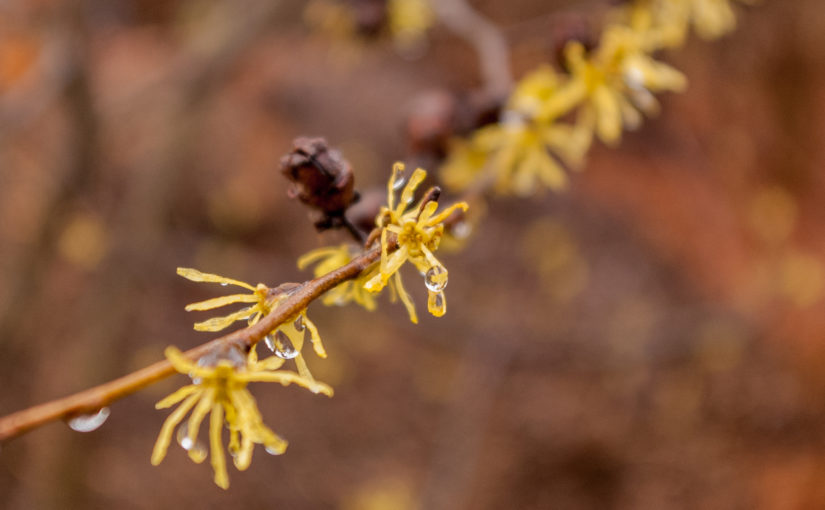
Common Witch Hazel – Late Fall Bloom
Common Witch Hazel (Hamamelis virginiana) is an underappreciated small tree. It blends into the background most of the year until late Fall when in bloom. How many other trees are in bloom in early December?

A closeup of Common Witch Hazel blooms. I took this picture on a cold and wet December morning with sleet on the ground from the previous night’s storm. Where to Plant Common Witch Hazel
Don’t use Common Witch Hazel in your foundation planting. It’s informal habit won’t work with modern homes. If you live in a rustic log cabin nestled in the woods I say, “Go for it!”
Plant this large shrub on the edge of the woods where it can blend in most of the year and give late Fall interest.

I planted my Common Witch Hazel at the back of my shrub border. You don’t notice it until late November to early December. For more information visit the Missouri Botanical Garden website.
-
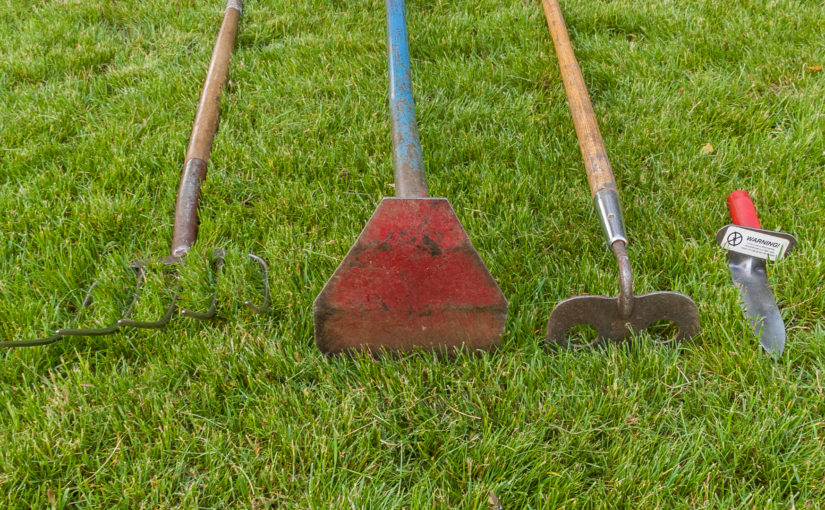
Weeding Tools Recommendations
Today I used several weeding tools to maintain a garden overgrown with weeds.
Truth be told it was my fault.
Last fall I overseeded the lawn and some seed found its way into the beds. The gardens were a mix of grass, dandelions and chickweed.
I spent the afternoon ‘hacking’ away at the weeds with my weeding tools. I’d like to share the method to my madness with you.
Weeding Tools Recommendations
First, I went through the beds with my weeding knife (Far right) and pulled the dandelions. If you cut dandelions with a hoe the long tap-root will grow back. You have to dig down and remove the root.
Next, I went through the front of the bed with my grub hoe (Second from left). The grub hoe packs more of a punch than a hoe. It’s perfect for removing heavy weeds and sod.
I used my cutting hoe (Second from right) where the weeds were sparse. A cutting hoe with a sharp edge is the right tool for stray chickweed.

Piles of weeds at the front of the bed ready to pick up with a manure fork. A manure fork is a perfect tool to load weed piles into a wheelbarrow. A manure fork has sharp tines and lightweight. I recommend you buy a 5 tine manure fork.
I hope you’ll try one of the weeding tools above to improve your productivity when weeding gardens.
